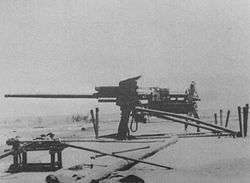Type 4 Chi-To
| Type 4 Chi-To | |
|---|---|
|
Type 4 Chi-To medium tank | |
| Type | Medium tank |
| Place of origin | Empire of Japan |
| Production history | |
| Designed | 1943–1944 |
| Number built | 2 |
| Specifications | |
| Weight | 30 tonnes (30 long tons; 33 short tons)[1] |
| Length | 6.42 m (21 ft 1 in)[1] |
| Width | 2.87 m (9 ft 5 in)[1] |
| Height | 2.87 m (9 ft 5 in)[1] |
| Crew | 5[1] |
|
| |
| Armor | 12–75 millimetres (0.47–2.95 in) |
Main armament | Type 5 75 mm tank gun (L/56.4) |
Secondary armament | 2 × Type 97 heavy tank machine guns |
| Engine |
Mitsubishi AL Type 4 37.7 litre air-cooled V12 diesel engine with supercharger |
| Suspension | Bell crank |
Operational range | 250 kilometres (160 mi)[1] |
| Speed | 45 kilometres per hour (28 mph)[1] |
The Type 4 medium tank Chi-To (四式中戦車 チト Yonshiki chūsensha Chi-To) ("Imperial Year 2604 Medium Tank Model 7") was one of several medium tanks developed by the Imperial Japanese Army towards the end of World War II. While by far the most advanced Japanese wartime tank to reach production, industrial and material shortages resulted in only six chassis being manufactured; only two of these were completed with neither seeing combat.[2]
Design




The Type 4 Chi-To was a thirty-ton, all-welded medium tank with a maximum armor thickness of 75 mm (3.0 in) on the frontal plates.[2] Manned by a crew of five, it was 6.42 m (21.1 ft) long, 2.87 m (9 ft 5 in) high, and 2.87 m (9 ft 5 in) wide.[1] Main armament was a turret-mounted long-barreled (4.23 m) Type 5 75 mm tank gun capable of being elevated between -6.5 to +20 degrees. An 850 metres per second (2,800 ft/s) muzzle velocity gave it an armor penetration of 75 millimeters at 1,000 meters.[3][4] Firing a 6.62 kg AP shell at a muzzle velocity of 821 m/s (2,690 ft/s) gave it an armor penetration of 200 mm of steel plate at 100 m according to the Japanese tests. A single 7.7 mm machine gun was mounted in the hull.[5]
The Type 4's 400 hp (300 kW) gasoline engine was significantly more powerful than the 180 kW (240 hp) engine of the 19-ton Type 3 Chi-Nu,[6] giving it a top speed of 45 km/h (28 mph) on tracks supported by seven road wheels. The tank had a range of 250 km.[7]
Development
Development of the Type 4 Chi-To began in 1943 as an intended successor to the Type 97-Kai Shinhoto Chi-Ha. The Army Technical Bureau had been working on the Type 4 Chi-To as the counter to the M4 Sherman, but there were problems and delays in the program. As a result a stopgap tank was required. The Type 3 Chi-Nu medium tank was developed to cope with the M4 Sherman.[8] Finally, the first prototype Type 4 Chi-To was delivered in 1944. Similar in appearance but significantly larger than the Type 97, it was the most advanced Japanese tank to reach production.[2]
Intended Type 4 Chi-To output was 25 tanks per month spread over two Mitsubishi Heavy Industries factories. Late war shortage-induced delays caused by the severing of supply lines with conquered territories and U.S. strategic bombing of the Japanese mainland resulted in only six chassis being built by 1945. Just two tanks were completed and neither saw combat.[2][9]
At the end of World War II the two completed tanks were dumped into Lake Hamana in Shizuoka Prefecture to avoid capture by occupation forces. One was recovered by the US Army, but the other was left in the lake. In 2013 there were efforts to locate the remaining tank, but it was not found.[10]
Variants
- Type 4 Chi-To (57mm) was the first ever prototype version, which later had its gun replaced with the Type 5 75mm gun.
Notes
- 1 2 3 4 5 6 7 8 9 Tomczyk 2005, p. 30.
- 1 2 3 4 Zaloga 2007, p. 22.
- ↑ Taki's Imperial Japanese Army: "Tank Guns"
- ↑ Hara 1972, p. 18
- ↑ Miller 2000, p. 187.
- ↑ Zaloga 2007, pp. 20–22.
- ↑ Tomczyk 2005, pp. 20, 27, 30.
- ↑ Taki's Imperial Japanese Army: "Tanks after Chi-Ha"
- ↑ Tomczyk 2005, pp. 19, 22.
- ↑ Takagi, Shogo Lake Hamana searched for WWII sunken tank April 17, 2013 The Japan Times Retrieved April 3, 2016
References
- Hara, Tomio (1972). Japanese Medium Tanks. AFV Weapons Profiles No. 49.
- Miller, David (2000). The Illustrated Directory of Tanks of the World. Zenith Imprint. ISBN 978-0-7603-0892-9.
- Tomczyk, Andrzej (2005). Japanese Armor Vol. 4. AJ Press. ISBN 978-8372371676.
- Zaloga, Steven J. (2007). Japanese Tanks 1939–45. Osprey. ISBN 978-1-8460-3091-8.
Further reading
- Foss, Christopher (2003). Great Book of Tanks: The World's Most Important Tanks from World War I to the Present Day. Zenith Press. ISBN 0-7603-1475-6.
- Foss, Christopher (2003). Tanks: The 500. Crestline. ISBN 0-7603-1500-0.
- Gander, Terry J. (1995). Jane's Tanks of World War II. Harper Collins. ISBN 0-00-470847-4
External links
 Media related to Type 4 Chi-To at Wikimedia Commons
Media related to Type 4 Chi-To at Wikimedia Commons- Taki's Imperial Japanese Army Page